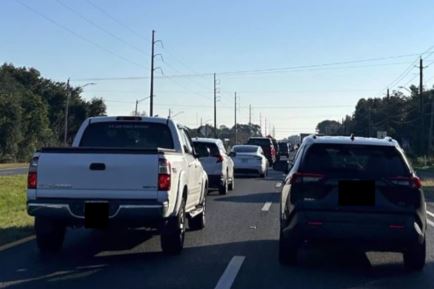
A recent proposal now out for public comment has brought into sharp focus what should already be obvious to anyone living, working, or serving along Florida’s Highway 98: this is not just a traffic problem. It is a 10-plus year story of failed leadership at the local, state, and federal levels—a cautionary tale about what happens when words and studies are substituted for meaningful action.
The stretch west of Hurlburt Field has become a daily choke point, strangling the flow of traffic and quality of life. When I moved here in 1997, Navarre was a quiet community of just over 10,000 people. Today, it is home to more than 40,000. Further west, communities have swelled at an even greater pace, more than quadrupling in size. All of this growth has poured five times the volume of vehicles onto a highway never designed to carry it.
Highway 98 is not just crowded—it is fragile. With no true alternative short of an hour-long detour up to I-10, a single accident cascades into chaos. Thousands upon thousands of people are stranded, late to work, late to school, or simply stuck. The entire coastal economy slows to a crawl at the mercy of one roadblock. This is not an inconvenience; it is a systemic vulnerability.
At a recent Santa Rosa County BOCC meeting, 1st Special Operations Wing Commander Col. Patrick Dierig put into words what many already fear: Highway 98 traffic now directly impacts the ability of the 1SOW to accomplish their mission of providing Specialized Airpower in defense of this nation. When the daily commute of airmen threatens operational readiness, the problem has crossed from civic frustration to national security risk.
And yet—what has been done? Meetings. Studies. Words. Proposals. Task forces. More studies. More words. What we have not seen is decisive action. Leadership at every level has kicked the can down the road while the road itself has become a chokehold on growth, prosperity, and even defense.
Action Today
It is true that large-scale fixes—additional lanes, bypass routes, flyovers—take years of planning, funding, and construction. But there are smaller, common-sense steps that could be taken today to ease the pain.
Let’s start with traffic lights. Everyone knows there are too many cars on the road, but one of the most maddening issues is that the lights along Highway 98 are not synchronized. Back in 2014, I tested it myself. Over the course of a month, I got stuck at every single light from Hurlburt to Navarre. I reached out to then-Commissioner Rob Williamson, who punted to Public Works Director Avis Whitfield. Whitfield promised to notify the contractor. Nothing changed. I reached out again and was punted to Assistant Public Works Director Glenn Bailey. His response was bureaucratic perfection: “Highway 98 is a state road under the jurisdiction of the Florida Department of Transportation. However, the County is the liaison for reporting and coordinating traffic signals along Hwy 98. I will forward your concerns to the FDOT and/or the signal contractor and have them take a look at the signal timing to ensure it is working correctly or make repairs as needed. I will follow up with you once I have more information.”
I never heard another word.
And here we are, ten years later, still waiting for “a study” on synchronized lights. One can only imagine the scale of this research effort, since apparently it requires more than a decade of analysis to figure out how to make a green light lead to another green light. Meanwhile, motorists endure daily stop-and-go misery on what should be a simple, manageable improvement. I served two tours at the Pentagon. I have lived and driven in the gridlock of Washington, D.C.—a city with traffic so infamous it has entire federal agencies devoted to solving it. Even there, synchronized signals and real-time flow management were implemented to ease the pain. Yet here, along a national defense corridor, we’re told that synchronizing and managing a few dozen lights is beyond our reach. That is not a problem of technology—it is a problem of leadership.
Second, until there is a wide-scale plan in place, work with the state to hire traffic officers who can monitor and adjust the lights in real time to compensate for traffic flow. This is not a new idea—many large cities employ officers or traffic control centers to respond in the moment to accidents, surges, or bottlenecks. It would cost far less than a new road and could start tomorrow. The technology exists. The people exist. The will does not.
Long-Term Solutions
Of course, short-term fixes only buy us time. The larger problem demands bold, long-term solutions—and accountability. There is plenty of blame to go around: unrestrained growth, surging military population across the tri-county area, and an absence of real planning. Every level of government—local, state, and federal—has failed.
And the federal government does have the power to step in. In fact, it must. The 1SOW and AFSOC are caught in the middle, but let’s be clear: Hurlburt Field sits on land that is part of Eglin Air Force Base, under Air Force Materiel Command. As the range owner, AFMC has dug in its heels, refusing to yield even an inch. I understand—the ranges are a national asset. But creative leadership would find a way.
A western gate at Hurlburt, running along the range boundary, would provide immediate relief. Allowing the use of a small strip of federal land would not compromise the mission, nor would it disturb endangered species. The reticulated salamander would be just fine. Precedents already exist: look at Highway 285 in Niceville, a shortcut to I-10. The government owns it, controls it, and occasionally closes it for testing. Look again at Highway 98 itself: there are times when the government closes it completely to allow training forces to cross. Exceptions are made when it suits federal priorities—why not when it serves both the mission and the community?
Widen the road, another perfect example of failed leadership. For some reason areas west of Navarre received funding to widen the road before the stretch between Hurlburt and Navarre, simply unbelievable. Widening the road will NOT solve the problem, but it is a small incremental step that when added with others will help.
HOV lanes. Again, having lived in Washington DC I used a reversable HOV lane every day on my commute to the Pentagon. While not optimal for 98, there are sections where it may work. I am not saying it is the answer, but it should be considered…every alternative should be considered. It takes creativity, leadership and Will to expand beyond building a bypass through HBTS on residential streets.
Finally, we need LEADERSHIP NOW. If I were county commissioner, I would do two things: first, drive Highway 98 during rush hour until I fully understood the misery my constituents endure daily. Second, I would plant myself or another rep in Tallahassee and Washington, D.C.—every week if necessary—until real solutions were on the table. That is what leadership looks like. Be a pain in the governor’s side, be a pain in the Florida Legislature’s side, be a pain in Congress’s side, be a pain in SECDEF’s…let them all feel the pain the residents who drive on Highway 98 feel until real action is taken.
Time’s Up
The people of Santa Rosa County deserve better. The men and women of Hurlburt Field deserve better. The nation deserves better. We do not need more meetings or promises of future studies. We need small, immediate fixes now and bold, long-term solutions next. Highway 98 is more than a road. It is a test of leadership. And for more than a decade, too many in positions of authority have failed that test. It is time—past time—for action.
Craig Walker, Col, USAF (RET), Navarre































